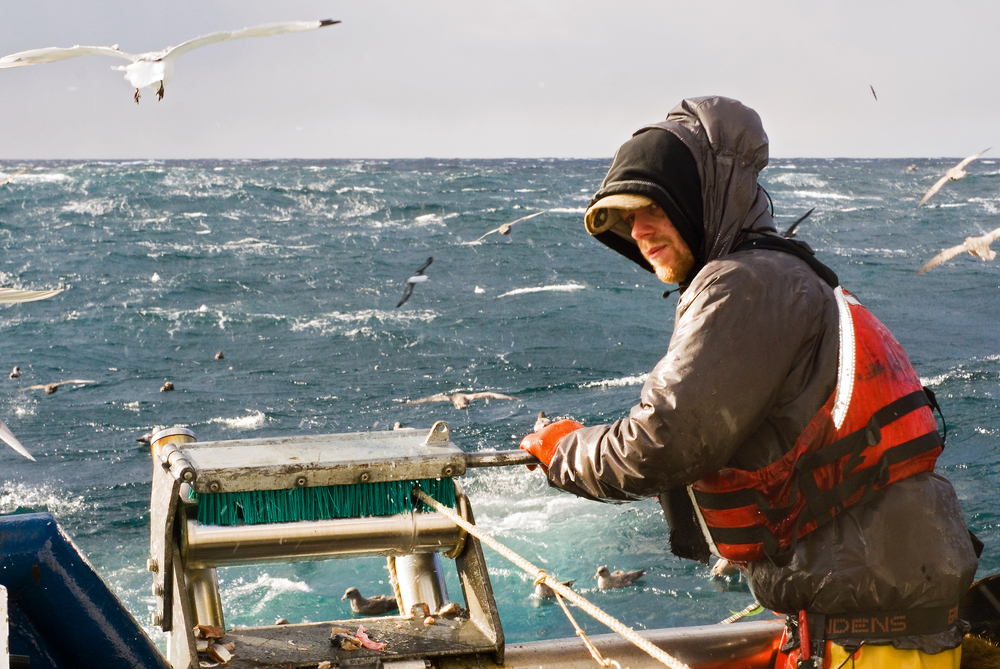All posts by NFI
John Connelly Celebration of Life Remembrance & Reception at GSMC
In November a bright light was extinguished from our world. On Sunday, January 15 from 5 p.m. – 6 p.m., we will remember the life of John Connelly, NFI’s President & CEO from February 2003 – November 2022. All attendees are welcome. Following the remembrance, please join John Connelly’s family, industry friends and the NFI Staff for an evening reception from 6 – 8 p.m. in the beautiful La Quinta Grove, where we will enjoy seafood and share fond memories of John. Attire for both events is Resort Casual.
Can Pregnant Women Eat Fish? Your Guide to Eating Fish During Pregnancy
The Question Used to Be: “Can pregnant women eat fish?” Or “can pregnant women eat seafood?”
Now the question is: are pregnant women eating enough fish or seafood during pregnancy?
The USDA/HHS’s Dietary Guidelines for Americans recommend eating a variety of cooked seafood 2-3 times each week during pregnancy. But the average pregnant woman in the U.S. eats less than half a serving. That’s a huge problem that we all need to do our part to help solve.
It’s critically important for moms-to-be to eat more seafood because the combination of nutrients found in fish are in especially demand by your body during pregnancy.
So, What Are the Benefits of Eating Fish During Pregnancy? What Kind of Nutrients Do Fish Contain That Are Important For Pregnant Women?
Fish contain the a variety of nutrients that are especially important for moms-to-be:

Omega-3 DHA (“Omega-3’s”)
The omega-3 fatty acid docosahexaenoic acid, or DHA, is a special kind of healthy fat that helps build your baby’s brain and eyes. During the last trimester, a fetus’s brain and nervous system rapidly develops, requiring about 65 mg/day of DHA. This heightened demand for DHA continues until your child reaches two years of age. Omega-3 DHA also nourishes moms’ brain health, and may even prevent depression during and after pregnancy.
It’s critical for women to eat fish during pregnancy because its he most widely available dietary source of omega-3 DHA there is. Fish like salmon, canned or pouch tuna, sardines, trout, and anchovies are rich in omega-3 DHA. There are other nutritional sources of DHA, including milk and eggs that have specifically had DHA added to them, also called DHA fortified milk or DHA fortified eggs.
Protein
Protein is needed to build a baby’s skin, muscle, hair, and bones. Moms-to-be need about 25 extra grams of protein every day to support their growing baby.
Fish and shellfish, eggs, beans, peanut butter, and dairy like cottage cheese are all good sources of protein. Fish has the added benefit of being lower in bad fats than some other animal sources of protein, like red meat.
Vitamin D
Vitamin D helps the body absorb nutrients like calcium, which builds a baby’s bones, teeth, heart, nerves, and muscles, while also keeping mom’s bones and teeth strong. Vitamin D may also help lower your chance of getting high blood pressure during pregnancy.
Your body actually makes Vitamin D, in a process linked to the amount of sunlight you absorb each day. That’s why younger and older people, people with darker skin, and people with limited sun exposure are at greater risk of Vitamin D inadequacy or deficiency.
You can get Vitamin D from dietary sources to make up for any shortfall produced by your own body, but the dietary sources of Vitamin D are relatively limited. And at the top of the list are fish like salmon, shrimp, and canned or pouch tuna. Other options include milk or orange juice specifically fortified with added Vitamin D.
Iron
Iron helps carry oxygen from a mom’s bloodstream to her baby. Iron also helps keep moms’ immune system strong. Most moms-to-be begin their pregnancies without enough iron in their diets.
Many people think of meats like turkey, beef, and chicken as top sources of iron. However, seafood like clams, halibut, crab, shrimp, and cooked oysters are also iron-rich. Vegetarian sources include red and kidney beans.
So, What Are The Healthiest Fish To Eat During Pregnancy? Are There Any Fish To Avoid During Pregnancy?
A quick internet search reveals that confusing “top fish to eat” lists abound, but the truth is that the best advice on fish and seafood for moms-to-be is pretty simple. Pregnant women can and should be enjoying a lot of different kinds of fish and other seafood. Popular types like catfish, clams, cod, crab, pollock, salmon, scallops, shrimp, tilapia, trout, and canned tuna are all safe fish, healthy fish to eat during pregnancy. Just like it’s best to eat a variety of fruits and vegetables, the recommendation is to eat a variety of seafoods to get the full range of nutrients found in different types of fish and shellfish. So moms-to-be should generally just eat a variety of the types of seafood they like most – they should just do it more often.
All types of seafood – frozen, fresh, and canned – count. It’s easy to forget that fish is found in three places in the grocery store. The seafood counter, of course, but also the canned goods aisle and the freezer section. It doesn’t matter which one women choose – all contain the nutrients, like omega-3s, that make seafood such a smart choice. So stock the kitchen with a variety of seafood options so there is a go-to no matter what sounds good. To give just two examples:
Canned Tuna
Canned tuna is one of the most affordable, available forms of omega-3s in the American diet. And canned tuna is a great choice for fish to eat while pregnant. There are two primary types of canned tuna, white (also known as albacore) and light. Women who are pregnant or breastfeeding can eat all types of tuna, including white (albacore) and light canned tuna as part of a variety of 2-3 servings of seafood each week.
Crab
Crab is a great choice for moms-to-be because it has a mild, sweet flavor and is rich in omega-3s. Consider adding crab or tuna to dishes you already love like macaroni and cheese.
Are There Any Fish to Avoid During Pregnancy?
There are only a handful of fish high in mercury to avoid, and the easy part is that most Americans rarely eat these fish anyway. They include shark, swordfish, king mackerel, tilefish, marlin, orange roughy, and bigeye tuna (found in some sushi).
Essentially all seafood includes traces of mercury in addition to beneficial nutrients like omega-3s. Scientists have closely studied the health effects on children when their moms eat fish during pregnancy. They repeatedly conclude that eating seafood 2-3 times each week during pregnancy boosts babies’ brain development. The World Health Organization points out that avoiding seafood may actually mean missing out on the best possible brain development for babies.
Can Pregnant Women Eat Sushi?
To reduce the chance of getting sick from food, women shouldn’t eat any raw meats during pregnancy. Sushi is tasty, nutritious and fun; just make sure to stick with cooked types during pregnancy. There are many types of cooked sushi—just look for the “cooked” sticker when shopping in the grocery store, or ask the server when dining out.
Can Breastfeeding Women Eat Fish?
Pregnant women who are already in the groove of eating seafood should keep it up after the baby arrives. The omega-3s found in seafood make their way to breastmilk and help nourish babies’ rapidly growing brains. Cooking and preparing many kinds of fish is also fast, and so fits well into busy new moms’ lives. Fish-loving parents set a positive example for their little one, who will be eating solid foods in just 4-6 months.
What are some Healthy Fish Recipes?
Whether you’re pregnant or breastfeeding, it may make sense to eat several mini-meals instead of a big meal. Consider thinking of seafood as an add-on to mini meals and snacks morning, noon, and night. Combine canned tuna, a hard-boiled egg, and cheddar cheese for a mid-morning meal. Top tilapia with mango salsa and wrap in a corn tortilla for lunch. Mix canned salmon with olive spread and eat with a couple slices of a French baguette for a snack. Toss pasta with sundried tomatoes and shrimp for a quick dinner. Visit Dish on Fish for more ways to get at least two seafood meals each week.
So, can pregnant women eat fish you ask? YES.
Author’s Note: We used the words “seafood” and “fish” interchangeably.
New Seafood Forms Aim to Improve Buyer Process
NFI and FMI – The Food Industry Association launched new resources designed to standardize the seafood buying process and improve efficiency. Retailers and wholesalers can use these fillable forms when sending seafood product specifications to suppliers. The goal is to streamline and standardize the language and specifications for each seafood species to help suppliers comply and fill orders.
Forms currently exist for shrimp, scallop and snow crab, salmon and steelhead.
You can access the forms below:
- Shrimp Specification Form
- Scallop Specification Form
- Snow Crab Specification Form
- Snow Crab Glossary
- Steelhead Specification Form
- Salmon Glossary
- Salmon Working Specification Form
For more information, visit www.AboutSeafood.com.
The Facts About Seafood Sustainability
Six Truths of Seafood and Seafood Sustainability
When you see the men and women who work the water to provide delicious, nourishing seafood to a growing planet, you see true stewards of seafood sustainability. But they rarely pause long enough to tell the tale of a protein that has nourished civilizations for millennia. Instead, misinformation and misrepresentation too often rule the narrative. Hyperbolic, so called documentaries, and distorted myths twist a reality that is focused on health and true science, both human and environmental. Let’s gather around for the real story of seafood.
U.S. Fisheries are based on science and regulatory oversight
U.S. fishermen and women have proudly supported science-based approaches to marine fisheries management that have made our industry, and our fisheries conservation and management processes, a global model of sustainability. With science being the backbone of The National Oceanic and Atmospheric Administration’s (NOAA) regulatory system, the agency operates an inclusive and transparent system that has led the U.S. to be a world leader in seafood sustainability. NOAA’s continued success in fisheries management is guided by the Magnuson-Stevens Fishery Conservation and Management Act (MSA).
The MSA requires that U.S. fisheries be managed to sustainable harvest rates and to achieve broader marine biodiversity goals, including habitat conservation and protection regulations under the full force of law with the greatest footprint of any ocean governance process in the nation.
As a result, U.S. fisheries produce exceptional environmental outcomes, preserve vital cultural traditions, create jobs in communities across the United States, contribute to U.S. food security, and deliver the healthiest animal protein on Earth to consumers.
Global sourcing and seafood sustainability
When demand for seafood increases in this country we don’t simply pull more out of the water, we look to trusted trading partners around the globe to fill that need. What’s more, we look to aquaculture to complement seafood sustainability. These days more than half of all seafood on the planet is farmed. NOAA notes that production from wild capture fisheries reached a plateau in the 1980ies and spurred more aquaculture, which is now the fastest growing form of food production in the world.
NOAA’s latest fisheries report shows “the vast majority of U.S. fish stocks continue to be strong, successful and achieving long-term sustainability goals.” Meanwhile, data from the United Nations Food and Agriculture Organization (FAO) finds biologically sustainable fisheries produce 82% of the seafood we eat.
When it comes to the seafood community, sustainability continues to be a priority for globally and locally sourced products.
Seafood is one of the most sustainable animal proteins on the planet
Despite the mass amount of confusing and contradictory messaging on seafood sustainability out there, seafood is one of the most sustainable animal proteins. U.S. fisheries are curators of the environment, producing one of the lowest carbon footprints of any protein across the globe.
The World Resource Institute’s protein scorecard ranks eating seafood as better for the planet in terms of impact on the environment, with both wild-caught and farmed fish have an enviable low emission footprint. In fact, a recent study found that certain popular wild-caught seafood products are more climate-friendly than a purely vegan diet. A recent New York Times expose about the impact of food on climate change also spotlights certain wild-caught seafood as “great low-carbon choices.”
The benefits of eating seafood
At a time when Americans are told to limit so many foods, seafood is among the handful of foods Americans are encouraged to eat more often. Fish is low in total fat, high in protein, and rich in vitamins and minerals, like selenium, vitamin D, and B vitamins. Plus, seafood is the premier dietary source of healthy omega-3 fatty acids.
The latest Dietary Guidelines for Americans encourage families to eat seafood at least twice weekly because of its heart and weight benefits. The Guidelines also underscore the importance for pregnant and breastfeeding women to eat more seafood to improve babies’ health. A staggering 94% of children and 80% of adults currently do not meet the Dietary recommendation to eat seafood twice per week. In fact, a study estimates that low seafood intake is responsible for about 84,000 American lives lost to heart disease each year, which makes seafood deficiency the second-biggest dietary contributor to preventable deaths in the U.S.
For pregnant moms, it’s more critical than ever to focus on eating nutrient-dense foods, like healthy seafood, to meet your growing nutrient needs. One of the most important prenatal nutrients is the omega-3 fatty acid DHA, which is vital for a baby’s healthy brain and eye development. Since your body can’t produce this healthy fat on its own, it needs to come from your diet. Fatty fish are among the best food sources of DHA.
Scientific approach to sustainability
When we’re talking about things like nutrition it’s important to remember that despite being a super food, packed with nutrients and vital components to health, seafood is still just food. It’s not medicine, it’s a meal. It’s allowed to be delicious, fun and not so serious. When it comes to seafood sustainability and fisheries management science is kinda serious.
A science-based approach to taking care of the stocks is a must and real stewards of sustainability embrace this notion fully. The goal of fishery managers is to maintain fish stocks near their Maximum Sustainable Yield (MSY.) Regulators target the MSY because it ensures the food resource has been made the most of without jeopardizing the future of the stock. In other words, feeding people now and later.
In the U.S. NOAA’s National Marine Fisheries Service spends nearly a billion dollars a year in support of science-based fisheries management. In the end, seafood is a science-based renewable resource.
Jobs
In the U.S., the seafood value chain provides 1.7 million jobs and accounts for $170.3 Billion in sales. From exports, to imports and retail to restaurant seafood is a thriving sector that is the life blood of many communities. So remember, when you seafood, see jobs.
For more on the true story of seafood visit AboutSeafood.com.
Good Housekeeping / Bad Housekeeping
Everyone is entitled to their favorite brand or variety of canned tuna, and we don’t begrudge the writers and editors at Good Housekeeping for sharing a list of theirs with their readers. There are lots of perfectly fine reasons to prefer one kind over another. Maybe it’s the flavor, varieties or ingredients; maybe it’s availability in your neck of the woods; maybe it’s what your dad or your grandma used to pack in your lunch as a child; or maybe you just prefer one cartoon mascot above all the others.
But Good Housekeeping is simply wrong to insinuate that there is anything more dangerous or harmful about certain brands or varieties, at least when it comes to the ones Americans can find on their grocery store shelves.
Most glaringly, their list warns that white or albacore tuna contains “more than three times the mercury” of light tuna, made from skipjack, yellowfin, and the like. What they don’t say is that no canned tuna variety contains anywhere near enough mercury to approach levels of concern set by government authorities. In fact, you could eat tuna for breakfast, lunch, and dinner every day and not risk exposing yourself to worrying levels. It simply isn’t a consideration.
So the entire apparent basis for ranking brands like “Safe Catch” at the top of their list seems to disappear. As we’ve covered at length elsewhere, Safe Catch is marketing itself as a solution to a problem that doesn’t exist.
The list also falls for some of the oldest and emptiest claims peddled by the kind of brands who specialize in marketing on nonissues that sound superficially virtuous. Perhaps the most pernicious of which is the claim that pole-and-line caught fish are more “eco-friendly” than netted fish. But that reflects a naïve understanding of the pole and line process, which requires orders of magnitude more boats, hours, and fuel to fish than other methods, resulting in higher prices for consumers and higher greenhouse gas emissions for the environment. Pole and line certainly has a place in wild harvest fisheries as do many methods but the idea that it alone is some sort of eco-panacea is gullible.
Oh, and GoodHousekeeping boasts that consumers should choose one of its top picks because the brand’s cans are “BPA free”. But that is hardly unique. Most American canned tuna brands have made the intentional choice not to add BPA to their can liners.
We don’t want to complain too much, since after Good Housekeeping makes great, true points about the versatility, tastiness, and nutritional oomph of canned and pouched tuna. And for that we commend them. But when readers are told that taking advantage of everything tuna has to offer comes with a tricky calculus—and that you have to consider multiple complex variables to make sure your selection at the shelf isn’t going to do you more harm than good—they risk concluding that it’s more trouble than it’s worth. That could lead to them reaching for a less complicated—and less healthy, and less sustainable—alternative.
A New USC Study Supports the Scientific Consensus on Moms and Seafood
A new USC seafood study on the connection between maternal seafood consumption and children’s health was recently released. And while the study isn’t the last word on the matter it is consistent with the overwhelming scientific consensus that seafood consumption has real and lasting benefits for expectant mothers and growing children.
The media coverage of the research, however, is mixed at best and marked by confusing or inaccurate descriptions of its results and significance. Some of the coverage, like a story from NBC’s affiliate in Los Angeles, even inaccurately claims that the study shows the highest levels of seafood consumption by moms yielded an adverse effect on children’s health. That’s not just false, it’s irresponsible, and will only further the confusing and conflicted advice too many moms get on seafood and health.
Here’s what you need to know:
- The USC seafood study finds that moms eating seafood 2-3 times a week during pregnancy is associated with improvements in a variety of health markers in their children. These include waist circumference, insulin levels, HDL cholesterol levels, and markers for inflammation.
- The study findings support the USDA Dietary Guidelines for Americans, which recommend that pregnant women eat 2-3 servings of seafood each week.
Here’s how the study worked:
- Researchers looked at 805 moms and their children aged 6-12 from across Europe (where seafood consumption is higher than the U.S., incidentally).
- Fish intake was broken down into 3 categories: low (ate fish less than once a week), moderate (ate fish one to three times a week), and high (ate fish more than three times a week).
- Fish intake was based on dietary recall, meaning they simply asked participants what they ate rather than directly observing it.
- Then, they measured some key elements of the children’s health, including waist circumference, blood pressure, HDL cholesterol, triglycerides, and blood insulin levels.
What did they find?
- Compared with low fish intake, moderate fish intake during pregnancy was associated with a decrease in children’s metabolic syndrome score, a key measure of health.
- High fish intake during pregnancy was also associated with a decrease in metabolic syndrome score, though the effect was a bit smaller.
- Even a doubling in moms’ mercury levels were associated with higher metabolic syndrome score.
- Compared with low fish intake and low mercury levels during pregnancy, the combination of moderate fish intake and low mercury exposure was associated with the greatest decrease in metabolic syndrome score, while the combination of low fish intake and high mercury exposure during pregnancy was associated the greatest increase in metabolic syndrome score.
What’s more, the study does not show high fish consumption is linked to any adverse effects on children’s metabolic health. And, that the coverage suggesting otherwise is perpetuating dangerous myths, not facts supported by evidence.
Even as we point out the coverage that got this study wrong, it’s important to highlight the coverage that got it right. The New York Times, for instance, correctly described the study’s finding that the highest weekly fish consumption was not found to have an additional benefit above three servings a week. This is a far cry from the NBC LA story’s insinuation of adverse effects and fear-mongering about mercury.
Decades of studies show the brain benefits of pregnant women eating seafood 2-3 times every week. This study shows that the benefits of pregnant women eating seafood 2-3 times each week extends beyond baby’s brain development. The bottom line is that this study’s findings support the recommendation that pregnant women should eat a variety of seafood 2-3 times each week for a variety of important health benefits. Expectant moms deserve the best science on seafood and nutrition, and a press that knows how accurately to present it.
Times Like These Call For Safe, Healthy Seafood
The medical and nutrition community, globally, agree; seafood is the healthiest animal protein on the planet. A stream of recommendations and reports scream Eat These Foods Now to Boost Your Immunity, What to eat to stay healthy and happy and 11 Healthy Long-Lasting Foods For Self-Isolation. Seafood is, and has been, on the front lines of the fight for personal health and longevity.
Seafood is also an important economic driver in this country, from the men and women who work the water, to those who cut and truck the fish that ends up on American plates. The Department of Commerce estimates seafood accounts for half a million U.S. jobs and more than 100 billion in sales.
The COVID 19 pandemic is a serious concern effecting not only public health but commerce at every level. While we have all been asked to attend to our individual health by practicing social distancing and following the recommendations of experts, the government should take action to protect the supply chain. Maintaining access to safe healthy food, like seafood, while safeguarding the jobs of those who produce it is imperative. Americans can do their part by continuing to buy from restaurants through carry out and, of course, from retailers to enjoy at home.
Keeping Americans and the seafood community healthy is vital.
Everything You Need to Know About Sustainable Seafood, Wild-Caught, and Farm-Raised (Aquaculture) Fish
Click Here: Sustainable Seafood Side by Side PDF
Thinking About Sustainable Seafood
We get it. There is a lot of confusing and contradictory messaging on seafood sustainability out there. You want reliable, accurate, and straightforward information about how much and which kinds of sustainable seafood you should be eating—and, if there is anything you should avoid. With more and more farm-raised fish options available, you also want to know that aquacultured fish is just as good for you as wild-caught.
You care about seafood sustainability, too, so you want to know which sourcing methods are ethical and environmentally responsible.
Lastly, if you’re pregnant, breastfeeding, have other nutrition sensitivities, or you are giving personal or professional guidance to someone who does, you want to make sure that all of this is safe and healthy for you and those you care about.
Don’t worry, we’ve got you!
Here is what you need to know.
A Great Majority of Seafood Is Sustainable
The news on seafood sustainability is unequivocally, inarguably GOOD. The majority of fish stocks around the world, including the most widely-eaten varieties in the U.S., are healthy and thriving.
That’s thanks to decades of hard work from international organizations dedicated to preserving and improving fishing practices and management.
Meanwhile, overfishing in the United States is at an all-time low.
The internet is full of confusing and complicated guides and lists, often from less than reputable sources. But you’re not on your own when it comes to seafood sustainability.
The reality is that seafood retailers and restaurants are already putting a huge amount of work into ensuring their products come from sustainable sources. Many of the largest grocery stores have great sustainable seafood policies you can view online. If you are shopping at one of these stores, you should feel confident about your purchases.
What About Farm-Raised (Aquaculture) Fish?
Farm-raised (or aquaculture) fish is a healthy choice. It provides heart-healthy omega-3s, vitamin D, and protein, and is low in saturated fat. According to the 2015 Dietary Guidelines Advisory Committee, both wild-caught and farm-raised fish have the same broad health benefits – reduced risk of heart disease and improved brain development. Even better? Both are widely available from sustainable seafood sources.
In contrast to other sources of animal protein, which often require significantly altering or transforming the natural environment, wild-caught and aquacultured seafood have a considerably smaller footprint.
The most widely eaten seafood in the U.S.—salmon and shrimp—come from a mix of wild-caught and farm-raised sources. This mix affords year-round availability, increasing their value and appeal as key nutritional staples.
A wider availability also helps keep prices reasonable, giving cost-conscious consumers more affordable healthy options, which means better decisions about what protein goes on the plate. And sourcing from a mix of wild and farmed stocks helps keep wild populations sustainable.
So What SHOULD I be Worried About When it Comes to Seafood Sustainability?
The biggest thing to worry about when it comes to seafood? Scientific research shows the biggest concern you should have is whether you are eating enough of it.
The average American eats just one serving of seafood weekly. And studies show that the kind of contradictory advice they are getting online—including “good versus bad” fish lists—are making things worse, since confused consumers avoid seafood all together.
The science is overwhelmingly clear that the health benefits of eating seafood are real, and they far outweigh any perceived risks.
Some people may need a more specific plan of action than “eat more seafood,” and they’re in luck. The USDA’s Dietary Guidelines for Americans recommend that all Americans eat at least 2-3 servings of a variety of seafood each week. That’s 8 to 12 ounces every week.
Want to Dive Deeper?
So while seafood sustainability is a hugely complex topic, the bottom line for consumers is actually pretty simple.
Eat more of a variety of seafood—start at two or three times a week. Choose farm-raised fish and/or wild-caught. Aquaculture is great, wild-caught is great. And, check your store’s sustainability section online for information on the varieties you prefer. (But if you’re wondering whether most common types of both farm-raised and wild-caught seafood are sustainably produced, the answer is almost certainly yes.)
To find out more, check out the National Oceanic and Atmospheric Administration (NOAA), which has a great resource called FishWatch. It gets into everything from sourcing and health benefits to taste and availability. http://www.fishwatch.gov/
Or perhaps you want to take a deeper dive into seafood because you’re a health-care provider or nutrition professional who advises others about health and diet. In that case, there is a great resource from a nonprofit group panel, the EAT-Lancet Commission on Food, Planet, and Health. Their work studies what diets are good for people and the planet. To meet the nutritional needs of the planet into the future, the report recommends we increase our intake of seafood, fruits, and green vegetables. The optimum omnivore diet is defined as being built around fish and shellfish, with no distinction between farm-raised and wild-caught. These findings also have the support of the Food and Agriculture Organization of the United Nations (FAO) and its Sustainable Development Goals (SDG). FAO is working at a global and government level to spread the word about the importance of eating enough—and eating a variety—of seafood.
Janelle Monáe Mercury Poisoning: Not From Seafood
Janelle Monáe Mercury Poison: Janelle Monáe Joins the Dubious List of Amateur Celebrity Doctors Dispensing Advice That’s Bad for Your Health
Janelle Monáe is a talented actress and musician. But you know what she is not? A doctor. Or a nutritionist. Or a toxicologist. So why are checkout aisle magazines like People taking at face value her recent claim to be recovering from “mercury poisoning” due to her pescatarian diet? We’ve heard this kind of unsupported claim from celebrities and pseudo-lifestyle gurus before. And it’s not just uninformed—it’s dangerous.
Arguably the most important shortcoming in the American diet is a lack of seafood. Low seafood consumption is linked by hundreds of peer-reviewed studies to poor heart health and brain development, and thousands of early deaths each year. 90% of Americans already fall short of government recommended seafood intake, and baseless claims like Monáe’s only perpetuates the kind of fear that keeps fish off their plates.
Janelle Monáe Mercury Poison: Not Seafood Related
There has never—ever—been a case of mercury poisoning from the normal consumption of commercial seafood found in any published, peer-reviewed medical journal. It’s simply not something that happens—amateur self-diagnoses from pop stars aside.
This isn’t a case where you “have to hear both sides” or look at competing evidence—because one side doesn’t have any. Fish is an important source of key nutrients and a widely-recognized building block of a healthy diet. Nobody who is buying farm-raised or wild-caught seafood from reputable supermarkets or restaurants is in danger of “mercury poisoning.” Even if you’re a pescatarian. Even if you’re eating, say, tuna for breakfast, lunch, and dinner every day. Even if you’re Janelle Monáe.
The Science-Based Health Advice Environmental Activists Don’t Want You To Hear
Threat of Mercury: Spreading the Mercury Myth
Quacks, hucksters, and snake-oil salesmen peddling junk science and miracle cures have been around at least as long as the traveling medicine shows of the Old West. But whereas the flimflam men of the pre-digital world could deceive only as far as the sound of their voice would carry, a new generation of shamans and gurus are exploiting mass media, internet virality, and social networks to mislead ever greater swaths of the public in the course of lining their own pockets.
Often, the humbug they hock is relatively harmless—many fad diets, for instance, are unlikely to actually hurt people who try them, whether or not they bring any real or lasting benefit. But the constellation of myths and mistruths surrounding seafood is unique in this area, and public health is already suffering in a very real way from the propagation of false and harmful claims about mercury.
Why You Should Eat More Seafood
Virtually every major health organization in the United States wants you to eat more seafood as part of a healthy diet. In “Dietary Guidelines for Americans,” the federal government recommends that everyone should increase their consumption of seafood, and that pregnant women in particular should eat at least 2 to 3 servings each week. That’s because seafood provides nutrients that benefit cardiovascular health: A Harvard study showed that some 84,000 cardiac-related deaths could be prevented each year with proper servings of fish in the diet. Another long-term study showed that children whose mothers ate three to four servings of fish a week had IQ scores that were 2.8 percent higher than those whose mothers ate less fish.
Surprised? Studies Show Alarmist Information Scares Consumers Away from Healthy Options
If this information surprises you—if you are surprised to learn that eating seafood not only won’t harm you, but that it is essential for better health—it is precisely because of the dangerous and irresponsible behavior of environmental activists who have taken advantage of a media environment where the loudest, most ridiculous claims get the greatest attention with the least scrutiny. According to the National Academy of Sciences, distorted and alarmist information being trumpeted by eco-activist groups is leading to reduced consumption of the very kinds of food you should be eating.
Exploiting the Mercury Myth at the Cost of Public Health
These groups are able to worm their way into publications by exaggerating the potential for harm and then offering “solutions” that are anything but. In a recent “Food Poisoning News” article, for example, NRDC hypes the threat of mercury in fish, when in fact there are only a small number of species of fish that pregnant women should stay away from because of higher mercury levels. They include shark, swordfish, king mackerel, tilefish, marlin and orange roughy. Most people rarely or never eat these kinds of fish anyway, so the advice NRDC offers serves only to discourage people from eating fish at all. Not surprising for an organization whose website markets a “safety zone” calculator that says certain fish can cause brain damage.
Organizations that use this kind of hyperbole refuse to look at the data and face the reality that the benefits outweigh any potential harm. It is a dangerous game to downplay the health benefits of eating fish. Americans don’t wind up in the hospital because they consumed fish with miniscule trace amounts of mercury that have always been present because of geo-thermal activity or other simple, scientific reasons. There’s not even a single case of mercury poisoning from normal commercial seafood consumption in any U.S. medical journal. But they certainly are healthier the more fish they consume.
Who Got It Wrong:
That won’t dissuade these groups from continuing to champion their message, especially as news outlets are keen to pick it up. Over the last year alone, we’ve seen Care2, Glamour, USA Today, Reader’s Digest, and Woman’s Day run with stories highlighting the threat of mercury in fish, playing up a threat that is already small, while entirely ignoring the importance of eating seafood. This leads to confusion among readers about what they should be doing, to the detriment of their health.
Activist groups that champion this message don’t care about sound science or you and your health. They care about fundraising and their own survival. Ignore the noise. Help your health. Eat more seafood.
Learn more about fish and mercury on our blog.












